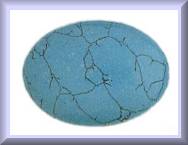


|
Turquoise is a Hydrous basic phosphate of copper and aluminum, occasionally containing some iron. It ranges from pale sky-blue to bright blue, and through bluish green or even (rarely) pale green. (The more iron, the greener the stone.) The name, “Turquoise,” or “Turkish,” in French, derived from the mistaken belief that it had been mined in Turkey. The mines that produced those stones, however, were in Persia, though they arrived in Europe via the Turkish trade routes. This is one of the oldest gemstones known to man. Turquoise mines in the Sinai Peninsula are known to have been worked as early as 5,500 BCE. Some beautiful, high-quality Turquoise is mined in the Southwestern United States. Some of these mines were in operation at least as early as 700 CE, and quite probably much, much earlier. Native Americans have long valued it, Americans both for its beauty and its Magickal properties. One of the four Elemental Stones of the Pueblo Peoples (along with Coral, Jet and Abalone Shell), Turquoise was held to be a connector of Earth and Sky. Some tribes joined Turquoise and Coral in jewelry because they believed that these two stones embodied the four elements of Earth, Air, Fire and Water. (Turquoise came from the Earth, with the color of Sky, or Air, while Coral came from the Sea, for Water, but was the color of Fire.) Believed by many to be the “Master Healer,” Turquoise is held to be helpful in virtually all illnesses of the body, mind and/or spirit, and to help align and open the Chakras. Physically, it aids the circulatory, nervous and respiratory systems. It strengthens the blood and aids in tissue regeneration. It strengthens vision and helps to prevent or even cure cataracts. It is frequently worn by transplant recipients to help avert rejection of the donated organ. For this reason, healers frequently wear Turquoise to increase their power. This stone is also said to heal the emotional "heart" of the individual. In addition it has been recommended for healing stomach disorders and for the eyes. On a non-physical level, Turquoise is used to enhance peace of mind and emotional balance. These properties enable the stone to aid as a focus in meditation. It is believed to increase wisdom, and aids in communication, while strengthening friendship and loyalty. It is also highly regarded as an artist’s stone, stimulating creativity and artistic expression. Magickally, Turquoise is used for protection, especially against traumatic injuries. Even today it is common to see valuable horses wearing Turquoise (set in saddles, bridles, etc.) to protect them against broken bones. Turquoise is set into the door of a dwelling to help prevent evil spirits from entering. Turquoise is frequently used in Prosperity Rituals. The Navajo believed that throwing a piece of Turquoise into a river would bring rain. |